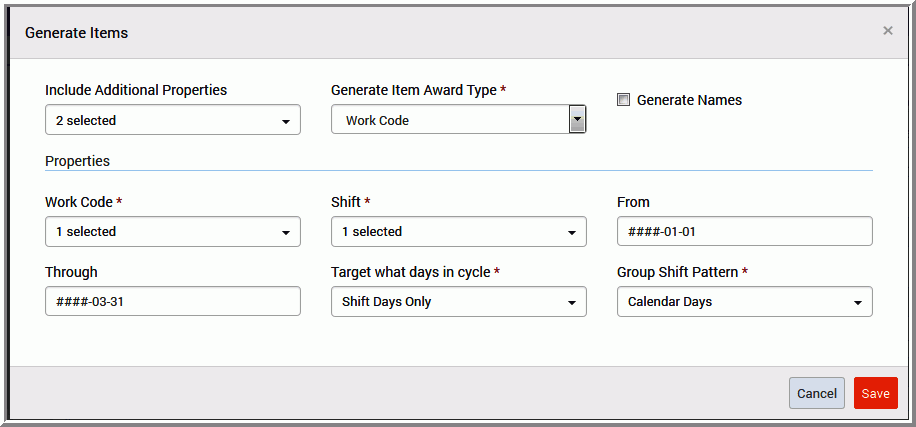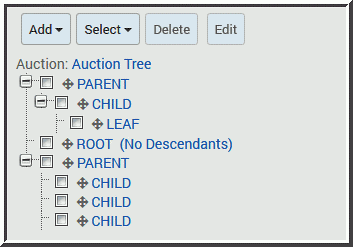The task below shows an example of the necessary steps
to generate a work code type auction. Configuration requirements
vary across customers and industries. Use the steps below to obtain a
general idea of how to configure a work code type auction.
- Bidders List Plan - A list plan is
required to create the list of bidders. Required for both Queue and Preference auctions.
- Win Order List Plan - A list plan is required
to process the win order for all Preference type auctions.
- Win Order List Plan - A list plan is required
to process the win order for a work code type auction.
- See Generate Field Descriptions topic for field definitions.
To configure a basic work code type auction:
- Go to Setup > Bidding > Auction
- Click Add to create a new auction.
- In the Auction screen, configure these fields:
- Name the auction.
- Enter the Effective Date.
- Select the Bidders List Plan from the Bidders drop-down.
- Select the Win Order List Plan from the Win Order drop-down if
this is a Preference auction. Skip this option for a Queue auction unless
instructed to select by an application expert.
- Select Queue or Preference from the Bid Method drop-down.
- Click Save.
- Go to the left panel of the Auction, and click Add
> Generate items...
The Generate Items properties dialog shows only
the required fields for the selected items.
- To start a basic work code auction, select the Award
Type: Work Code. A red asterisk next to the field name
denotes a required field. For this task, populate the fields indicated
below only:
- Select the work code from the Work Code drop-down
that will be placed on the person’s calendar to indicate the time-off;
for example, Vacation.
- Select the shift or shifts applicable to this auction from the Shifts drop-down.
For this auction example, select one shift to keep the list of auction
items relatively small.
- Enter the start date of the first auction item available to
all users across multiple shifts in the From field. Do not
enter the start of the shift, this is the start of the entire auction
across applicable shifts. The Bidding module will automatically
determine the exact ‘working’ day and present auction items applicable
to the logged in user based on the effective date; shift or the
shifts selected; and the user’s personal information.
- Enter the last date of the auction in the Through field.
Do not enter the shift end, this is the end of the entire auction. TIP:
For testing, use a small window of dates, such as 90 days to quickly
build the auction, fine tune, and tweak the auction before generating
the entire auction.
- Select Shift days only from the Target days what days
in cycle drop-down.
- Select Calendar Days from the Group Shift Pattern drop-down.
- Click Save.
To apply a Formula ID and make the dates comprehensible,
go to the Auction Items list and select one of the auction
items.
- Go to Select > Select All same level to select
only Child items. Doing so will exclude the Parent level
from the Formula ID.
- Select the desired Formula ID from the Formula ID drop-down.
- Click Save to resolve the Formula IDs. The auction
items will display the new name.
To control the visibility of this Auction, go to the
Parent level in the auction tree.
- Enter PERSONHASSHIFT in the Visible Condition field.
- Click Save.
To control which items are biddable for this Auction,
go to the Child level of the auction tree.
- Select a Child or an auction item, and then click Select
> Select all same level to select all applicable auction items.
- Select Condition from the Biddable Condition, drop-down.
Enter PERSONSHIFTWORKING to show auction items relevant to
the bidder’s shift, including time-off already on the calendar.
- Click Save.
To apply the Bidding Plan and make this Auction
available in the Manage Bidding area, go to Setup > Bidding
> Plan.
- Click Add to create a new plan.
- Label the Plan and assign this auction to the selected Bidding
Plan. Doing so will make this auction available in the Bidding area.
- Click Save.
The Auction is available in the Bidding area. Click the
Manage link, to navigate to the applicable auction. Go to the bidders
list pane. Click the gear icon, and select Create bidders list to
view the bidders for this auction. Depending on your settings, you
may need to click the Auction button in the right panel, and select Open
auction.


